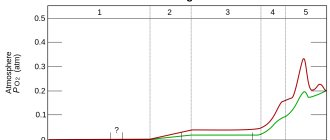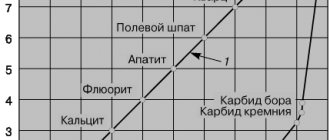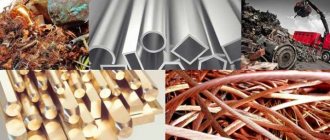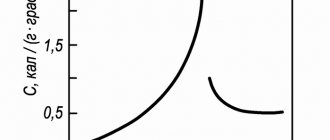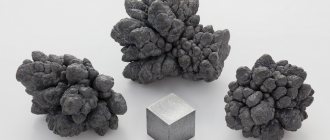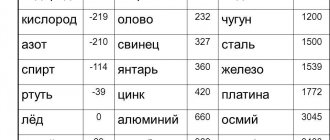Characteristics of carbon. Properties of simple substances and compounds
Carbon (C) is a typical non-metal; in the periodic table it is in the 2nd period of group IV, the main subgroup. Serial number 6, Ar = 12.011 amu, nuclear charge +6.
Physical properties: carbon forms many allotropic modifications: diamond is one of the hardest substances, graphite, coal, soot .
The carbon atom has 6 electrons: 1s22s22p2. The last two electrons are located in separate p-orbitals and are unpaired. In principle, this pair could occupy the same orbital, but in this case the interelectron repulsion greatly increases. For this reason, one of them occupies 2px, and the other, either 2py or 2pz orbitals.
The difference in the energy of the s- and p-sublevels of the outer layer is small, so the atom quite easily goes into an excited state, in which one of the two electrons from the 2s orbital passes to the free 2p. A valence state appears with the configuration 1s22s12px12py12pz1. It is this state of the carbon atom that is characteristic of the diamond lattice—tetrahedral spatial arrangement of hybrid orbitals, identical length and energy of bonds.
This phenomenon is known to be called sp3 hybridization, and the resulting functions are called sp3 hybridization. The formation of four sp3 bonds provides the carbon atom with a more stable state than three p-p bonds and one s-s bond. In addition to sp3 hybridization, sp2 and sp hybridization is also observed at the carbon atom. In the first case, mutual superposition of the s- and two p-orbitals occurs. Three equivalent sp2 hybrid orbitals are formed, located in the same plane at an angle of 120° to each other. The third orbital p is unchanged and directed perpendicular to the sp2 plane.
During sp hybridization, the s and p orbitals overlap. An angle of 180° arises between the two equivalent hybrid orbitals that are formed, while the two p-orbitals of each atom remain unchanged.
Allotropy of carbon. Diamond and graphite
In a graphite crystal, carbon atoms are located in parallel planes, occupying the vertices of regular hexagons. Each carbon atom is linked to three neighboring sp2 hybrid bonds. The connection between parallel planes is carried out due to van der Waals forces. The free p-orbitals of each atom are directed perpendicular to the planes of covalent bonds. Their overlap explains the additional π bond between the carbon atoms. Thus, the properties of this substance depend on the valence state in which the carbon atoms in a substance are located .
Carbon as a reducing agent:
- with oxygen C0 + O2 –t°= CO2 carbon dioxide with a lack of oxygen - incomplete combustion: 2C0 + O2 –t°= 2C+2O carbon monoxide
— with fluorine C + 2F2 = CF4
— with water vapor C0 + H2O –1200°= C+2O + H2 water gas
- with metal oxides. This is how metal is smelted from ore. C0 + 2CuO –t°= 2Cu + C+4O2
- with acids - oxidizing agents: C0 + 2H2SO4 (conc.) = C + 4O2 + 2SO2 + 2H2O C0 + 4HNO3 (conc.) = C + 4O2 + 4NO2 + 2H2O
— with sulfur forms carbon disulfide: C + 2S2 = CS2.
Carbon dioxide (carbon dioxide)
Methods for producing carbon dioxide
- CO2 – The end product of the oxidation of organic substances in the cells of aerobic organisms
- Formed by the action of strong acids on carbonates ( soluble and insoluble ) and bicarbonates of metals:
CaCO3 + 2HCl → CaCl2 + H2O + CO2
NaHCO3 + HBr → NaBr +H2O +CO2
- When soluble carbonates interact with soluble salts of aluminum, iron (III) and chromium (III), which are irreversibly hydrolyzed in an aqueous solution:
2AlCl3 + 3K2CO3 + 3H2O → 2Al(OH)3↓ + CO2↑ + 6KCl
- During the thermal decomposition of insoluble carbonates and during the decomposition of soluble hydrocarbonates :
CaCO3 → CaO + CO2
2NaHCO3 → Na2CO3 + H2O +CO2
- When burning all types of fuels:
СxHy + O2 = H2O + CO2
- During alcoholic fermentation of glucose under the action of enzymes:
С6H12O6 → 2CO2 + 2C2H5OH
Chemical properties of carbon dioxide
Carbon dioxide is a typical acidic oxide . Shows weak oxidizing properties
- Qualitative reaction to carbon dioxide - turbidity of lime water:
Ca(OH)2 + CO2 → CaCO3 + H2O
- Interacts with water , but the reaction is highly reversible, and only 1% of carbonic acid molecules combine with water:
CO2 + H2O ↔ H2CO3
- With basic oxides and strong bases (alkalis), to form carbonates or bicarbonates. In this case, the formation of both acidic and medium salts is possible:
Na2O + CO2 → 2Na2CO3
KOH + CO2 → KHCO3
2KOH + CO2 → K2CO3+ H2O
- With carbonates, with the formation of bicarbonates :
Na2CO3 + CO2+ H2O → 2NaHCO3
- With aqueous solutions of salts formed by acids weaker than carbonic acids (very weak acids):
Na2SiO3 + CO2 + H2O = H2SiO3 + Na2CO3
C6H5OK + CO2+ H2O → C6H5OH + KHCO3
- With some reducing agents:
CO2 + 3H2 → 2CH3OH + H2O
CO2 + C → 2CO
2Mg + CO2 → C + 2MgO
Attention! Magnesium burns in an atmosphere of carbon dioxide, so burning magnesium cannot be extinguished with carbon dioxide fire extinguishers.
- In the leaves of plants in the light, carbohydrates and oxygen are formed from CO2 and H2O:
nCO2 + mH2O = Cn(H2O)m + nO2
- With sodium peroxide to form sodium carbonate :
2CO2 + 2Na2O2 → 2Na2CO3 + O2
- Synthesis of carbamide (urea):
CO2 + 2NH3 = CO(NH2)2 + H2O
- Preparation of baking soda using the Solvay method:
NaCl + CO2 + NH3 + H2O= NaHCO3 + NH4Cl
Finding carbon in nature
Free carbon occurs in the form of diamond and graphite. In the form of compounds, carbon is found in minerals: chalk, marble, limestone - CaCO3, dolomite - MgCO3*CaCO3; hydrocarbonates – Mg(HCO3)2 and Ca(HCO3)2, CO2 is part of the air; Carbon is the main component of natural organic compounds - gas, oil, coal, peat, and is part of organic substances, proteins, fats, carbohydrates, amino acids that make up living organisms.
Carbon compounds
At the beginning of the 19th century, substances were divided into inorganic and organic. The second group includes hydrocarbons (methane, ethylene and acetylene series), proteins, carbohydrates, fats. Organic chemistry studies these substances.
Inorganic chemistry studies other carbon compounds: halides, cyanides, carbides, oxides. The most significant are oxygen-containing substances - CO, CO2. There is also C2O (dicarbon monoxide) and C3O2 (suboxide), but these are not yet well-studied substances.
Monoxide or carbon monoxide
Carbon monoxide 2 (another name for monoxide) - is formed during incomplete combustion of C or products containing it. Its main properties:
- It liquefies at a temperature of - 192 °C.
- Hardens at t=-205°C.
- Molecular weight - 28.01 g/mol.
- The structure of the molecule is linear (within the framework of the theory of valence bonds it can be written as “:C==O:”).
- It is practically insoluble in water.
Monoxide is a poisonous gas that is colorless and odorless. Its toxic effect is that it irreversibly interacts with hemoglobin in the blood, as a result of which the ability to transfer oxygen from the lungs to the tissues is completely lost.
In industry, monoxide is produced during the gasification process of solid fuel. In the laboratory, the compound can be synthesized by reacting concentrated sulfuric acid with oxalic acid (C2H2O4) or formic acid (HCOOH). The reaction occurs when heated:
- HCOOH → CO + H2O.
- C2H2O4 → CO + CO2 + H2O.
According to its chemical properties, divalent oxide is a good reducing agent. It burns well, releasing a large amount of heat: 2CO + O2 → 2CO2. Other characteristic features:
- The ability to “remove” oxygen from its compounds with metals: FeO + CO → Fe + CO2.
- In the presence of activated carbon, which acts as a catalyst, carbon monoxide with an oxidation state of +2 is capable of adding chlorine (Cl), thereby forming phosgene (COCL2), a chemical warfare agent. It is a colorless, highly toxic gas with the smell of rotten hay. The reaction equation for the production is: CO + Cl2 → COCl2.
- At high temperatures (above 400°C) and elevated pressure (300 atm) it reacts with hydrogen. As a result of the process, methyl alcohol (methanol) is formed: CO + 2H2 → CH3OH.
- At elevated temperatures, it reacts with alkalis, forming salts of formic acid (HCOOH): CO + NaOH → HCOONa.
- When interacting with ammonia, hydrocyanic acid is formed - a very toxic substance: CO + NH3 → HCN + H2O.
Carbon monoxide has wide practical applications. It is part of artificial gaseous fuel. In addition, it is indispensable in organic synthesis processes.
Carbon dioxide or CO2
It is a colorless gas with a weak sour odor and taste. The molar mass is 44.01 g/mol.
Note: carbon monoxide 4 is one and a half times heavier than air, so it can be “poured” from test tube to test tube.
Carbon dioxide (another name for carbon dioxide) does not support combustion. In addition, it makes breathing impossible: in a room where the concentration of the substance is high, a person will suffocate. What properties are inherent in the connection:
- Some substances that form a stronger bond with oxygen than carbon (for example, magnesium) can burn in carbon dioxide: 2Mg + CO2 → 2MgO + C.
- Combustion reaction with hot coal: CO2 + C → 2CO.
- Interaction with water: CO2 + H2O → H2CO3 (carbonic acid).
- Forms acidic oxides when interacting with basic oxides: Na2O + CO2 → Na2CO3 (sodium carbonate).
- With a lack of alkali, it forms hydrocarbonates: CO2 + NaOH → NaHCO3.
In industry, carbon dioxide is synthesized by thermal decomposition of limestone or chalk (sometimes dolomite, magnesite): CaCO3 → CaO + CO2. This substance can also be isolated from coke oven gas when burning coal, peat, oil products, and wood. In addition, it is also found in natural sources: for example, it “appears” as a result of volcanic activity, during the decay of organic substances.
In laboratory conditions, it is obtained by the interaction of CaCO3 and hydrochloric acid: CaCO3 + 2HCl → CaCL2 + CO2 + H2O (the reaction is carried out in a Kipp apparatus). Another way is to calcinate sodium bicarbonate: NaHCO3 → Na2CO3 + CO2 + H2O.
Carbon dioxide is of industrial importance: it is necessary in soda production, in the food industry (production of carbonated drinks), and for the synthesis of organic acids. Dry ice (solid dioxide) is used as a refrigerant - the carbon dioxide environment prevents food from decomposing. In addition, CO2 is also used in medicine (carbon dioxide baths to activate metabolic functions). It is also indispensable for agriculture - carbon monoxide IV is involved in photosynthesis, so its deficiency negatively affects plants.
Carbonyls.
Carbon monoxide is capable of reacting directly with many metals or metal ions, forming complex compounds called carbonyls, for example Ni(CO)4, Fe(CO)5, Fe2(CO)9, [Fe(CO)4]3, Mo(CO )6, [Co(CO)4]2. The bonding in these compounds is similar to the bonding in the cyano complexes described above. Ni(CO)4 is a volatile substance used to separate nickel from other metals. The deterioration of the structure of cast iron and steel in structures is often associated with the formation of carbonyls. Hydrogen can be part of carbonyls, forming carbonyl hydrides, such as H2Fe(CO)4 and HCo(CO)4, which exhibit acidic properties and react with alkali:
H2Fe(CO)4 + NaOH → NaHFe(CO)4 + H2O
Carbonyl halides are also known, for example Fe(CO)X2, Fe(CO)2X2, Co(CO)I2, Pt(CO)Cl2, where X is any halogen (see also ORGANOMETALLIC COMPOUNDS).
Nitrogen derivatives of carbon.
This group includes urea NH2CONH2 - a nitrogen fertilizer used in the form of a solution. Urea is obtained from NH3 and CO2 by heating under pressure:
Cyanogen (CN)2 has many properties similar to halogens and is often called a pseudohalogen. Cyanide is obtained by mild oxidation of cyanide ion with oxygen, hydrogen peroxide or Cu2+ ion: 2CN– ® (CN)2 + 2e.
Cyanide ion, being an electron donor, easily forms complex compounds with transition metal ions. Like CO, cyanide ion is a poison, binding vital iron compounds in a living organism. Cyanide complex ions have the general formula [M(CN)x]–0.5x, where x is the coordination number of the metal (complexing agent), empirically equal to twice the oxidation state of the metal ion. Examples of such complex ions are (the structure of some ions is given below) tetracyanonickelate(II) ion [Ni(CN)4]2–, hexacyanoferrate(III) [Fe(CN)6]3–, dicyanoargentate [Ag(CN)2] –:
Carbon
Atomic carbon is a very short-lived species and therefore carbon is stabilized in various polyatomic structures with different molecular configurations called allotropes. The three relatively well-known allotropes of carbon are amorphous carbon, graphite, and diamond. Previously considered exotic, fullerenes are now commonly synthesized and used in research; these include buckyballs, carbon nanotubes, carbon nanodots and nanofibers. Several other exotic allotropes have also been discovered, such as lonsaletite, glassy carbon, nanofaum carbon, and linear acetylene carbon (carbyne). As of 2009, graphene is considered the strongest material ever tested. The process of separating it from graphite will require some further technological development before it becomes economical for industrial processes. If successful, graphene could be used in the construction of space elevators. It can also be used to safely store hydrogen for use in hydrogen-based engines in cars. The amorphous form is a collection of carbon atoms in a non-crystalline, irregular, glassy state rather than contained in a crystalline macrostructure. It is present in powder form and is the main component of substances such as charcoal, lamp soot (soot) and activated carbon. At normal pressures, carbon has the form of graphite, in which each atom is trigonally bonded by three other atoms in a plane consisting of fused hexagonal rings, as in aromatic hydrocarbons 10). The resulting network is two-dimensional, and the resulting flat sheets are folded and loosely connected through weak van der Waals forces. This gives graphite its softness and cleavage properties (sheets easily slide past each other). Due to the delocalization of one of the outer electrons of each atom to form a π cloud, graphite conducts electricity, but only in the plane of each covalently bonded sheet. This results in lower electrical conductivity for carbon than for most metals. Delocalization also explains the energetic stability of graphite over diamond at room temperature. At very high pressures, carbon forms a more compact allotrope, diamond, having almost twice the density of graphite. Here, each atom is tetrahedrally connected to four others, forming a three-dimensional network of wrinkled six-membered rings of atoms. Diamond has the same cubic structure as silicon and germanium, and due to the strength of its carbon-carbon bonds, it is the hardest natural substance, as measured by scratch resistance. Contrary to popular belief that "diamonds are forever", they are thermodynamically unstable under normal conditions and turn into graphite. Due to the high activation energy barrier, the transition to the graphite form is so slow at normal temperatures that it is undetectable. Under certain conditions, carbon crystallizes as lonsalite, a hexagonal crystal lattice with all atoms covalently bonded and properties similar to those of diamond. Fullerenes are a synthetic crystalline formation with a graphite-like structure, but instead of hexagons, fullerenes are composed of pentagons (or even heptagons) of carbon atoms. Missing (or extra) atoms deform the sheets into spheres, ellipses, or cylinders. The properties of fullerenes (divided into buckyballs, bakitubes and nanobads) have not yet been fully analyzed and represent an intensive area of nanomaterials research. The names "fullerene" and "buckyball" are associated with the name of Richard Buckminster Fuller, the popularizer of geodesic domes, which resemble the structure of fullerenes. Buckyballs are fairly large molecules formed entirely from carbon bonds in a trigonal manner, forming spheroids (the most famous and simplest is the football-shaped buckynysterfellerene C60). Carbon nanotubes are structurally similar to buckyballs, except that each atom is trigonally bonded in a curved sheet that forms a hollow cylinder. 11) Nanoballs were first introduced in 2007 and are hybrid materials (buckyballs are covalently bonded to the outer wall of the nanotube) that combine the properties of both in one structure. Of the other allotropes discovered, carbon nanofoam is a ferromagnetic allotrope discovered in 1997. It consists of a cluster assembly of low-density carbon atoms stretched together into a loose three-dimensional network in which the atoms are trigonally linked in six- and seven-membered rings. It is among the lightest solids with a density of about 2 kg/m3. Likewise, glassy carbon contains a high proportion of closed porosity, but unlike regular graphite, the graphite layers are not stacked like pages in a book, but are more randomly arranged. Linear acetylene carbon has a chemical structure - (C:::C)n-. Carbon in this modification is linear with sp orbital hybridization and is a polymer with alternating single and triple bonds. This carbyne is of significant interest for nanotechnology because its Young's modulus is forty times greater than that of the hardest material, diamond. In 2015, a team from the University of North Carolina announced the development of another allotrope, which they called Q-carbon, created by a high-energy, low-duration laser pulse on amorphous carbon dust. Q-carbon is reported to exhibit ferromagnetism, fluorescence, and have a hardness superior to diamonds.
Chemical properties of carbon
Under normal conditions, carbon is an inert substance, but when heated it can react with a variety of simple and complex substances.
It was already said above that at the external energy level of carbon there are 4 electrons (neither here nor there), therefore carbon can both give up electrons and accept them, exhibiting reducing properties in some compounds, and oxidizing properties in others.
Carbon is a reducing agent in reactions with oxygen and other elements that have higher electronegativity (see table of electronegativity of elements):
- when heated in air it burns (with an excess of oxygen with the formation of carbon dioxide; with its deficiency - carbon monoxide (II)): C + O2 = CO2; 2C + O2 = 2CO.
- reacts at high temperatures with sulfur vapor, easily interacts with chlorine, fluorine: C + 2S = CS2 C + 2Cl2 = CCl4 2F2 + C = CF4
- when heated, it reduces many metals and non-metals from oxides: C0 + Cu+2O = Cu0 + C+2O; C0+C+4O2 = 2C+2O
- at a temperature of 1000°C it reacts with water (gasification process), forming water gas: C + H2O = CO + H2;
Carbon exhibits oxidizing properties in reactions with metals and hydrogen:
- reacts with metals to form carbides: Ca + 2C = CaC2
- interacting with hydrogen, carbon forms methane: C + 2H2 = CH4
Carbon is obtained by thermal decomposition of its compounds or pyrolysis of methane (at high temperature): CH4 = C + 2H2.
Application of carbon
Carbon compounds have found the widest application in the national economy; it is not possible to list all of them, we will indicate only a few:
- graphite is used to make pencil leads, electrodes, melting crucibles, as a neutron moderator in nuclear reactors, and as a lubricant;
- Diamonds are used in jewelry, as a cutting tool, in drilling equipment, and as an abrasive material;
- Carbon is used as a reducing agent to produce some metals and non-metals (iron, silicon);
- carbon makes up the bulk of activated carbon, which has found wide application, both in everyday life (for example, as an adsorbent for purifying air and solutions), and in medicine (activated carbon tablets) and in industry (as a carrier for catalytic additives, a polymerization catalyst etc.).
Top of page
